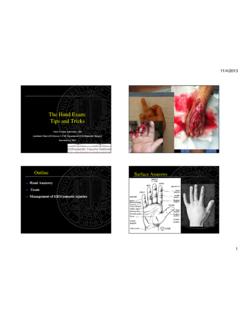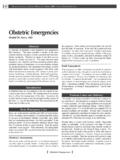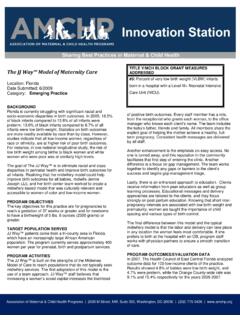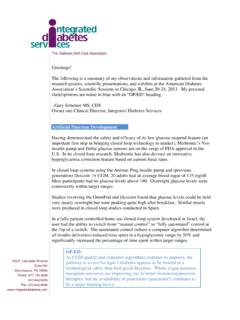Transcription of Intrapartum & Postpartum Nothing to disclose …
1 6/10/20121 Intrapartum & PostpartumBladder ManagementSharon K Knight, MDNothing to discloseOverviewIntrapartum & Postpartum Bladder Management Literature, available guide lines Fluid status, Avoid injury, UTIU rinary Retention Definitions, Incidence, Risk Factors Prevention ManagementCase 132 yo G1P1 6 weeks Postpartum I m wearing more diapers than my baby. L&D: -NSVD, epidural, 2ndstage-2h, 7#2oz male-No voluntary control noted when stood for first void attempt after delivery -Foley catheter expelled through urethra with inflated balloon during second stage6/10/20122 Case 238 yo G3P1 requiring clean intermittent catheterization after every void ~ 14 months post partum-L&D: epidural, 2ndstage 3 hours, forceps, 3rddegree laceration; voided small amounts, Discharged PPD#2-Presented to ED with abdominal discomfort, straining to void with only drops catheterized for 3700ccExperience with Similar Cases?
2 12345%20%35%40% number of complaints with regard to Postpartum bladder issues recognized by agencies (NHS, SA Medical) Prevalence Patient safety, Risk ManagementSignificant differences in managementLimited recommendations by professional societies (ACOG, RCOG) ACOGW omen should be encouraged to void as soon as possible after delivery . Often women have difficulty voiding immediately after delivery , possibly because of trauma to the bladder during labor and delivery , regional anesthesia, or vulvar perineal pain and swelling. In addition, the diuresis that often follows delivery can distend the bladder before the patient is aware of a sensation of a full bladder. To ensure adequate emptying of the bladder, the patient should be checked frequently during the first 24 hours after delivery , with particular attention to displacement of the uterine fundus and any indication of the presence of a fluid-filled bladder above the symphysis.
3 Although every effort should be made to help the patient void spontaneously, catheterization may be necessary. If the patient continues to find voiding difficult, use of an indwelling catheter is preferable to repeated for Perinatal Care, ACOG, 6thedition 2007. Guidelines for Perinatal Care, ACOG, 6thedition 2 Guidelines for Perinatal Care, ACOG, 6thedition 2007. 6/10/20123 RCOGW omen who have had a mid-cavity delivery , an epidural top-up or spinal are at risk of urinary retention. Consider inserting an indwelling catheter (to be kept in place for 12 hours post delivery ).For those women who do not have an indwelling catheter, a fluid balance chart should be kept for 24 hours and the timing and volume of their first void retention of urine is suspected, a post-void residual should be measured.(RCOG 2005) post-operative or post- delivery patient should be left more than 6 hours without voiding or Study Group Recommendation: Incontinence in Women 2002; 6:4 (June).
4 Survey ResultsOnly 23% of units complied with RCOG recommendation of catheterization within 6 hours if no voidDuration of catheterization varied markedly (6-24 hours); 47% had required no criteria to be met before removal of catheterInitial voided volume only recorded in 26% (NSVD), 47%(after removal of indwelling foley)Zaki et al 2004 Use of Indwelling Foley0%20% 40% 60% 80% 100%C-sectionEpidural in LaborInstrumental delivery3rd degreeIndwelling FoleyIndwelling FoleyZaki et al 20046/10/20124 IntrapartumIndwelling Continuous Foley Catheter(CC)vs. Clean Intermittent Catheterization (IC) -Effect on labor -UTI -Urinary retentionManagement of Foley during second stage-remove, deflate, continueEffect on Labor: Bladder Emptying A distended bladder, with or without a cystocele, may obstruct delivery . Williams Obstetrics 1993 Bladder emptying in women without epidurals (1ststage, active)-Reed et al: no effect on uterine activity or course of labor-Kerr-Wilson et al: increased uterine activity with no effect on course of laborEffect on Labor: Bladder EmptyingContinuous (CC) vs Intermittent Catheterization (IC) during Labor:-Duration of second stage of labor longer in CC group (105 +/- 72 vs 75 +/- 52 min (p= )-Increased local anesthetic dose in CC group (both stages of labor)IC group catheterizations: 1 (60%), 2 (23%), 3( ).)
5 False positive for clinical diagnosis of retention et al 2008 Infectious Risk (CAUTI)Asymptomactic bacteriuriaNo difference in CC vs IC ( 30%)1 Increased in IC group vs CC group2:1 Evron et al 2008 ,2 Millet et al 20120510152025 CDCISDACCIC6/10/20125 Iatrogenic catheter-related injury10-15% of hospitalized patients undergo insertion of a urinary catheterLimited data regarding iatrogenic catheter-related hospitalized (male) patients with catheter insertion-5% ICU patients, accidental removal of inflated balloon-No published data in obstetrics Kashefi et al, Lorente et alIatrogenic catheter-related injury:Second StageBladder trauma from compression against balloon Hematuria Ecchymosis, edema (unclear significance) FistulaUrethral trauma inflated catheter expelled during pushing or with descent of fetal headThe US Army Walter Reed Army Institute of Research (WRAIR) seeks a partner to license and commercialize a patent-pending safety adaptor for a Foley catheter.
6 The adaptor prevents injury to a patient in cases of accidental or deliberate removal of the catheter without deflating the anchoring Catheters?2ndStage Bladder Management: Hospital Protocols/PoliciesUCSF: No written policy. We remove (Foley) prior to pushing. If the second stage is lengthy, we will straight cath as needed. This has just always been the practice CPMC: Written policy. If Foley in place, deflate balloon and removecatheter at onset of pushing; for any bladder distension in second stage, performstraight cath. Kaiser SF: No specific policy in labor; general practice if epidural - Foley in for 1ststage and deflated for 2ndstage6/10/20126 Case 3G2P1 VBACL&D: Long labor, dense epidural, foley in for 1stand 2ndstage, >3 hour second stage, NSVD~1 hour after labor urine leakage noted from vagina Inspection in OR revealed erosion at anterior vagina with visible foley bulbEDEMANORMALPERMANENT DAMAGEMayo et al Br J UrolFig.
7 1 Fig. 1. A 10 cm-long defect at the dome of the urinary bladder is evident. Allis' clamps are holding the necrotic edge of the urinary bladder. The arrows show the hyperemic mucosa with fibrin as-Garc a. Postpartum Bladder Rupture. Obstet Gynecol 2012 Obstetrics & Gynecology. Published by Lippincott W illiams & W Rupture Caused by Postpartum Urinary RetentionDue as-Garc a, Omar Felipe; Rico, Hugo; Gorbea-Sanchez, Viridiana; Herrerias-Canedo, TomasObstetrics & Gynecology. 112(2, Part 2):481-482, August : VoidingAfferentinput arises from bladder stretch receptors (through myelinatedfibers in pelvic nerves) Efferentsignals mediate coordinated response: relaxation of the urethral/periurethralmuscles and pelvic floor striated muscles detrusor muscle contraction and urethral smooth muscle relaxation6/10/20127 How does term/ Postpartum bladder capacity compare to non-pregnant capacity?
8 12346%21%33% changePhysiologic ChangesAntepartum/PostpartumIncreased bladder capacity in 3rdmonth ga, progressively increases until 8th(Progesterone) ~200+cc at termPostpartum functional bladder capacity significantly higher than non-pregnant state*: </=699cc ( ) 700-999 ( ) >/=1000 (14%) of (total) patients required CIC*Burkhart et al 1965 Postpartum Voiding DysfunctionMultifactorialImpaired bladder emptying Detrusor Hypotonia (under activity, areflexia) Physiologic changes in pregnancy (progesterone) Neuropathy (pudendal and pelvic nerve injury, suppressed sensory impulses due to epidural analgesia) Over distention injury (unrecognized retention)Bladder outlet obstructionAnatomic obstruction Edema, hematoma, local bladder edemaFunctional obstruction Pain (perineal lacerations) Urethral over activity (reflex increase in tone) Postpartum Urinary Retention(PPUR)Incidence varies significantly due to definitions used ( )Covert : >/= 150cc post void residual volume, no symptoms of retentionOvert.
9 Inability to void spontaneously (within 6 hours after delivery or removal of Foley) Yip et al6/10/20128 PPUR IncidenceAuthor (n)Overt VaginalCovert VaginalOvert C-SectionKermans (789) (1000) (691) (15,757) (11,332) Risk Factors1. labor 2ndstage4. Epidural5. Instrumental delivery6. Perineal injury (laceration, edema, hematoma)7. Birth weight (> )8. Cesarean sectionHumburg et al: (>7 days) at least 4/6 RFs present in all patients with retention, most had 5/6 Risk Factors Multivariate AnalysisOVERTCOVERTK ermansNulliparityCS for FTP 1st StageAndolfForceps, VacuumNulliparityYipProlonged 1st& 2ndstagesTeoCaucausian vs Asian ( )Epidural ( )CarleyInstrumental delivery ( )Regional anesthesia ( )Groutz (>3d)Length of 2ndstageVacuum PPUR: ManagementPrevention/Early RecognitionAttention to bladder in labor and post partum (to avoid over distention) Have patient attempt to void every 2-3 hours in labor Assess voided volumes and bladder palpation on exam low threshold for CICC onsider indwelling Foley catheter (~12-24 hours) after instrumental delivery and/or regional anesthesia re-dosing just before delivery6/10/20129 PPUR.
10 ManagementPrevention/Early RecognitionIf unable to void by 6h ( Postpartum or after catheter removal) assess with PVR or CICHigh index of suspicion: Risk Factors Symptoms: urgency, frequency, hesitancy, decreased sensation to void, straining, small voids, incontinence Exam: uterus high/deviated, bladder palpable, small volume voids measured (<150cc) PPUR: Management Helping Measures Oral analgesia Ice pack to perineum Help patients stand and walk Provide privacy Warm bath Immerse hands into cold water Avoid constipationStallard et al 1988 Postpartum Voiding Timed voids every 3-4 hours; record volumesIf voids less than 150cc and/or other symptoms, check PVRIf (symptomatic) inadequate voids/retention : Urine C&S Indwelling catheter x 24 48 h (PVR >700)* If 2ndattempt unsuccessful, teach self CIC vs. catheter x 1 week (pain, edema)UCSF6/10/201210 Voiding After Vaginal delivery Algorithm Void by 4 hours Postpartum ?
















